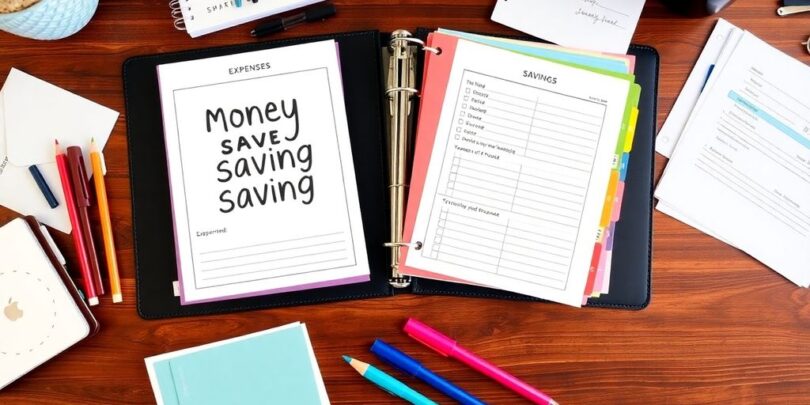Are you struggling to save money and keep track of your expenses? A money saving binder might just be the solution you need. This handy tool can help you organise your finances, set savings goals, and ultimately maximise your savings. In this guide, we’ll walk you through everything you need to know about creating and maintaining a money saving binder that works for you.
Key Takeaways
- A money saving binder helps you track expenses and savings effectively.
- Use budgeting sheets and expense trackers to stay organised.
- Incorporate cash envelopes for better spending control.
- Regular updates and reviews are key to maintaining your binder.
- Avoid common mistakes like neglecting to track expenses or overcomplicating the system.
Understanding The Money Saving Binder

What Is A Money Saving Binder?
Okay, so what is a money saving binder? Basically, it’s a physical or digital tool – usually a ring binder – that helps you organise your finances. Think of it as a central hub for all things budget-related. It’s where you keep track of your income, expenses, savings goals, and any other financial documents you might need. It’s not just about writing things down; it’s about creating a system that works for you, making it easier to see where your money is going and how you can save more. You can even incorporate budget binder envelopes to keep cash organised for different spending categories.
Benefits Of Using A Money Saving Binder
Why bother with a money saving binder? Well, there are heaps of benefits:
- Increased Awareness: You become more aware of your spending habits. Seeing everything written down makes it harder to ignore where your money is actually going.
- Better Budgeting: It helps you create and stick to a budget. When you have a clear overview of your finances, it’s easier to make informed decisions about where to allocate your funds.
- Achieving Savings Goals: It keeps your savings goals front and centre. This can be a great motivator to cut back on unnecessary spending and put more money towards your goals.
Using a money saving binder can really change your mindset around money. It’s not just about restricting yourself; it’s about being intentional with your spending and making sure your money is working for you, not the other way around.
How A Money Saving Binder Works
So, how does this magical binder actually work? It’s pretty simple, really. You start by gathering all your financial information – bank statements, bills, pay stubs, etc. Then, you use budgeting sheets and expense trackers to record your income and outgoings. Next, you set realistic savings goals and break them down into smaller, manageable steps. The key is to regularly update your binder and review your progress. This helps you stay on track and make adjustments as needed. It’s a hands-on approach to managing savings that puts you in control of your financial future.
Essential Components Of A Money Saving Binder
Budgeting Sheets
Okay, so budgeting sheets are where it all starts. Think of them as the foundation of your whole money-saving operation. You can find heaps of free templates online, or even just create your own in a spreadsheet. The main thing is to get a clear picture of your income versus your expenses. List everything – from your salary and any side hustle income to rent, bills, groceries, and that sneaky daily coffee.
- Income Tracking: Keep a record of all income sources.
- Expense Categories: Break down spending into categories like housing, food, transport, and entertainment.
- Monthly Summaries: Review your budget each month to identify trends and areas for improvement.
It’s easy to skip this step, but trust me, it’s worth it. Knowing exactly where your money is going is the first step to taking control of it.
Expense Trackers
Expense trackers are your detective tools. They help you monitor where your money actually goes, which can be quite different from where you think it goes. You can use a simple notebook, a dedicated app, or even a printable sheet in your binder. The key is consistency. Jot down every purchase, no matter how small. You’d be surprised how quickly those little expenses add up. This is especially useful when starting the 100 envelopes challenge.
- Daily Logging: Record every expense as it happens.
- Categorisation: Assign each expense to a budget category.
- Regular Review: Analyse your spending patterns to identify areas where you can cut back.
Savings Goals Templates
What are you saving for? A house deposit? A holiday? A new car? Having clear, defined savings goals is a massive motivator. A savings goals template helps you break down your big goals into smaller, more manageable chunks. Write down your goal, the target amount, and a realistic timeline. Then, track your progress along the way. Seeing those numbers creep up is seriously satisfying. Consider using printable cash envelopes to help you reach your goals.
- Goal Setting: Define specific, measurable, achievable, relevant, and time-bound (SMART) goals.
- Progress Tracking: Monitor your savings progress regularly.
- Visualisation: Use charts or graphs to visualise your progress and stay motivated.
Organising Your Money Saving Binder
Categorising Your Expenses
Okay, so you’ve got all these sheets and trackers, but where does everything go? First things first, you need to categorise your expenses. Think about what you spend money on regularly. Common categories include: Housing, Transport, Groceries, Utilities, Entertainment, Debt Repayments, and Personal Care. You can break these down further – for example, ‘Transport’ could be split into ‘Car Expenses’ (petrol, maintenance, registration) and ‘Public Transport’.
- Fixed Expenses: These are the same each month (rent, mortgage, loan payments).
- Variable Expenses: These change month to month (groceries, utilities).
- Savings Goals: Dedicated sections for different savings targets.
It’s a good idea to use colour-coded labels or dividers for each category. This makes it super easy to find what you’re looking for at a glance. Trust me, when you’re trying to quickly check your spending, you’ll thank yourself for being organised.
Using Dividers Effectively
Dividers are your best mate when it comes to keeping your money saving binder in order. Don’t just shove everything in randomly! Label each divider clearly with your expense categories. You can buy pre-made dividers or create your own using cardstock and a label maker. Consider using different coloured dividers for broader categories to make things even easier to find. For example, all ‘Needs’ could be in blue, and all ‘Wants’ could be in red. This helps you visually assess where your money is going. You might even want to include a section for budget calculator printouts to keep everything in one place.
- Use sturdy dividers that won’t bend or tear easily.
- Label each divider clearly and consistently.
- Consider using different colours for different categories.
Creating A Visual Layout
How your binder looks is actually pretty important. A visually appealing layout can make you more likely to use it regularly. Think about how you want to arrange your sections. Some people like to have their budgeting sheets at the front, followed by expense trackers, and then savings goals. Others prefer to group expenses by category. There’s no right or wrong way – it’s all about what works best for you. The key is to make it easy to understand and navigate.
Here’s an example of a layout:
| Section | Contents |
|---|---|
| Budget Overview | Monthly budget sheet, income tracker |
| Housing | Rent/mortgage statements, maintenance costs |
| Transport | Petrol receipts, public transport tickets |
| Groceries | Grocery receipts, meal planning sheets |
| Savings Goals | Savings goal trackers, progress charts |
Consider adding visual elements like stickers, motivational quotes, or even photos to make your binder more personal and engaging. A money saving binder should be a tool you want to use, not a chore!
Tips For Maintaining Your Money Saving Binder
Regularly Update Your Binder
Right, so you’ve got your money saving binder all set up. Now comes the bit that some people forget: actually using it! The key to a successful money saving binder is to update it regularly. I’m talking at least once a week, maybe even more if you’re a big spender. Think of it like this: if you don’t keep your binder up-to-date, it’s like trying to drive somewhere with an outdated map. You’ll end up lost and confused, and probably over budget.
- Record every expense, no matter how small. Those coffees add up!
- Update your savings goals. Are you on track? Do you need to adjust?
- Reconcile your binder with your bank statements. Make sure everything matches up.
Review Your Progress Monthly
Okay, so you’re updating your binder weekly. Good on ya! But that’s not enough. You also need to take a step back and review your progress monthly. This is where you really get to see the big picture. Are you actually saving money? Are you sticking to your budget? Are there any areas where you’re consistently overspending? This is where you can use budgeting apps to help you track your spending.
Here’s a simple way to review your progress:
- Grab a cuppa and find a quiet spot.
- Review each category in your binder. How did you do?
- Compare your actual spending to your budgeted amounts.
It’s easy to get discouraged if you’re not seeing results right away. But don’t give up! Remember, saving money is a marathon, not a sprint. Just keep plugging away, and you’ll eventually reach your goals.
Adjust Your Budget As Needed
Life happens, right? Your car might break down, your rent might go up, or you might just decide you really, really need that new gadget. That’s why it’s important to be flexible with your budget. Don’t be afraid to adjust it as needed. If you’re consistently overspending in one area, maybe it’s time to re-evaluate your priorities. Or maybe you can find ways to cut costs in other areas to compensate. Think about using a cash envelope system to help you stay on track.
Here are some things to consider when adjusting your budget:
- Are your savings goals still realistic?
- Have your income or expenses changed?
- Are there any unexpected expenses coming up?
Incorporating Cash Envelopes Into Your Binder

Choosing The Right Envelopes
Okay, so you’re thinking about adding cash envelopes to your money-saving binder? Good on ya! First things first, you gotta pick the right envelopes. You can grab plain ones from the newsagent, or go a bit fancier and get some wallets specifically designed for cash stuffing. It really depends on your budget and how much you want to invest in the system.
- Durability: Think about how often you’ll be handling them. Sturdier envelopes will last longer.
- Size: Make sure they fit comfortably in your binder without being too bulky.
- Visibility: Clear envelopes can be handy so you can see how much dosh is left without opening them.
Setting Up Your Cash Envelope System
Right, let’s get this show on the road. Setting up your cash envelope system is pretty straightforward. Decide which spending categories you want to use cash for. Groceries? Entertainment? Maybe even petrol? Write the category on each envelope. Then, at the start of each month (or week, depending on how you get paid), divvy up your allocated budget into the corresponding envelopes. The key is to only spend what’s in the envelope for that category.
It might take a few goes to figure out the right amounts for each envelope. Don’t stress if you go over budget in the first month. Just tweak it for the next one. It’s all about finding what works for you.
Tracking Cash Spending
This is where the binder comes in handy! You need to keep track of where your cash is going. You can do this in a few ways:
- Use a small notebook: Keep a small notebook in your binder and jot down every cash transaction.
- Printable trackers: Find some free printable expense trackers online and stick them in your binder.
- Spreadsheet: If you’re a bit tech-savvy, use a spreadsheet to track your spending.
Here’s a simple example of how you might track your spending:
| Date | Category | Description | Amount Spent ($) | Remaining ($) |
|---|---|---|---|---|
| 27/04/2025 | Groceries | Coles Supermarket | 85 | 115 |
| 27/04/2025 | Entertainment | Cinema Tickets | 40 | 75 |
Maximising Savings With Your Money Saving Binder
Setting Realistic Savings Goals
Okay, so you’ve got your money saving binder set up, which is awesome! But now what? It’s time to get serious about setting some goals. Don’t just say "I want to save money". That’s way too vague. You need to be specific. Think about what you’re saving for and how much you need. Is it a deposit on a house? A new car? A holiday? Write it down. Break down the big goals into smaller, manageable chunks. It makes the whole process way less daunting.
- Start small: Aim for achievable goals initially to build momentum.
- Be specific: Instead of "save more," try "save $50 per week."
- Track progress: Regularly review your savings against your goals.
Identifying Areas To Cut Costs
Right, time to get real about where your money is actually going. This is where your expense trackers come in handy. Go through them with a fine-tooth comb. Are there any subscriptions you’re not using? Any habits you can ditch? Maybe you’re buying too many coffees or eating out too often. Small changes can make a big difference over time. I found I was spending a fortune on impulse buys at the supermarket. Now I make a list and stick to it. It’s amazing how much you can save when you’re not throwing random stuff in your trolley. Using a savings challenge book can help you stay motivated and on track.
Utilising Discounts And Coupons
Alright, let’s talk about being a savvy shopper. Before you buy anything, ask yourself: is there a discount available? Check online for coupons, look for sales, and sign up for loyalty programmes. Even a small discount can add up over time. I’m a big fan of using cashback apps and websites. It’s basically free money! And don’t be afraid to haggle, especially on big purchases. You’d be surprised how often you can get a better deal just by asking. Think of it as a game, and see how much you can save. You can even use cash envelopes to avoid wasting money on unnecessary purchases.
It’s easy to get discouraged if you don’t see results straight away. But stick with it. The more you use your money saving binder, the more effective it will become. And remember, every little bit counts. Even if you’re only saving a few dollars here and there, it all adds up in the end.
Common Mistakes To Avoid With A Money Saving Binder
Neglecting To Track Expenses
One of the biggest traps people fall into is not consistently tracking their expenses. Your money saving binder is only as good as the information you put into it. If you’re not diligently recording where your money is going, you’ll struggle to identify areas where you can cut back and save more. It’s like trying to navigate without a map – you might get somewhere, but it’s unlikely to be where you intended.
- Make it a daily habit to record your spending.
- Use your expense trackers in the binder.
- Don’t forget small purchases – they add up!
It’s easy to think you’ll remember that coffee or the magazine you bought, but those small amounts can really impact your budget over time. Get into the habit of writing everything down, no matter how insignificant it seems. This will give you a much clearer picture of your spending habits.
Overcomplicating The System
Another common mistake is making the money saving binder too complex. People sometimes try to include too many categories, intricate tracking methods, or unnecessary details. This can lead to feeling overwhelmed and eventually abandoning the system altogether. Keep it simple! A straightforward, easy-to-use binder is much more likely to be maintained in the long run. If you are using a cash envelope system, make sure it is easy to understand.
- Start with essential categories.
- Use clear and concise labels.
- Avoid unnecessary spreadsheets or calculations.
Failing To Review Regularly
Setting up the binder is only half the battle. The real power of a money saving binder comes from regularly reviewing your progress and making adjustments as needed. If you’re not taking the time to analyse your spending, savings, and goals, you’re missing out on valuable insights that can help you optimise your financial strategy. Think of it like this: you wouldn’t plant a garden and then never check on it, would you?
- Schedule monthly review sessions.
- Analyse your spending patterns.
- Adjust your budget and goals as needed.
| Month | Target Savings | Actual Savings | Variance | Notes |
|---|---|---|---|---|
| January | $500 | $450 | -$50 | Unexpected car repair |
| February | $500 | $520 | +$20 | Reduced eating out |
| March | $500 | $480 | -$20 | Higher electricity bill due to heatwave |
Wrapping It Up
So there you have it! Creating a money-saving binder can really help you get a grip on your finances. It’s all about being organised and making your money work for you. You’ll find that tracking your spending becomes second nature, and before you know it, you’ll be saving more than you thought possible. Just remember, it’s a journey. Don’t stress if it takes a bit to get the hang of it. Stick with it, and you’ll see the benefits. Give it a go, and let me know how it works out for you!
Frequently Asked Questions
What exactly is a money saving binder?
A money saving binder is a tool that helps you keep track of your finances. It’s a folder or binder where you can store important documents like budgets, expenses, and savings goals.
What are the benefits of using a money saving binder?
Using a money saving binder can help you organise your money better, keep track of your spending, and achieve your savings goals more easily.
How does a money saving binder work?
A money saving binder works by allowing you to write down your budget and expenses. You can see where your money is going and make adjustments as needed.
What should I include in my money saving binder?
You should include budgeting sheets, expense trackers, and templates for your savings goals. These will help you stay organised and focused on your financial targets.
How often should I update my money saving binder?
You should update your money saving binder regularly, ideally every month. This way, you can keep track of your progress and make any necessary changes to your budget.
Can I use cash envelopes with my money saving binder?
Yes, you can! Cash envelopes can be a great addition to your money saving binder. They help you stick to your budget by allowing you to physically see how much money you have left for each category.









[…] like "saving for a rainy day" are less motivating than specific ones. Do you want to buy a house? A new car? Early retirement? Put a number on it and break it down into smaller, achievable […]
[…] it adds a bit of fun and excitement to their swimming gear. There are heaps of ways to customise a swim bag, from simple additions to more creative […]